Thanks for the comments regarding successfully flying commercially with plants. I do feel even more emboldened!
With my two little gardens, one in frost-free zone 10 and the other in zone 8b, I feel like I’m tumbling in and out of a multiverse of gardens. This was the scene in the Tillamook garden when I left for a brief trip to Southern California in late April. I’ve since cut the few remaining tulips for vases and cleared most of these pots out. This spring in the PNW is generally acknowledged as unusually cold and wet and is increasingly getting on everyone’s nerves. (Whereas, I will admit that when a couple days go by without rain, I get a little anxious, scarred by drought that I am!)
Forecasts for May show an increasing amount of dry days at widening intervals until June, when the rain mostly disappears for summer. Growth in the new garden is painfully slow, but little nubbins of green are starting to break ground. Locals say everything rushes into growth after Mother’s Day — and there was a noticeable uptick and surge. The splashiest plants so far for late April are geum and Euphorbia characias wulfenii — and I wished I’d planted more of the euphorbia. But there’s a chance they won’t age gracefully into summer here so some restraint is initially called for. (Cutting down the flowering stems when they’re finished will allow the new basal growth to develop and hopefully last through next winter.) Around town rhodies are in full bloom, with peonies and lilacs just getting started. Japanese maples seem to emerge fully leafed out nearly overnight.
This watching and waiting and longing for growth is kind of deliciously excruciating — since for me it’s still such a novel experience. My sympathies to the veterans! Understandably, since zone 8 can swing warmer or colder from year to year, experimentation with hardiness is irresistible. It’s a very emotional zone for hard-core gardeners, filled with drama-driven narratives of weather vagaries that don’t exist for zone 10 gardens, where the basic question of rain and the interminable lack of it relentlessly overrides and governs all other concerns.
In the left foreground, Sedum dendroideum, grown very lanky in a pot, seemed like unsightly evidence of neglect, all stems with a fritz of rosette at the tips — until I planted it in the garden last fall when I was thinning out potted plants for the caretaker’s benefit. Now I recognize the investment in years it took to make such a freaky 4-foot specimen. I wasn’t sure it would be self-supporting in the garden, but it is, and I love the height it lends.
Conversely, and no surprise, the frost-free Long Beach garden needed some severe discipline. A few plants like anisodontea, sonchus, and salvia needed to be cut back off their neighbors, but the bulk of the work was weeding out seedlings from the dry-laid bricks.
When home I do this absent-mindedly all the time. When allowed to accumulate over a couple months, it’s a real time sink — just me and a butter knife prying out nicotiana, Verbena bonariensis, argemone, sideritis, linaria…
A new addition to the vigorous self-sowing contingent, Silene fabaria ssp. domokina has left dozens of plants after its first year in the garden. I have to borrow Stellata Plants description of “a poor man’s Bukiniczia cabulica” because it perfectly describes this little charmer. The half dozen plants I’m trialing in the Oregon garden look slightly miserable, and if they survive they may behave like biennials with only leaf growth the first summer. It’s doubtful they’d survive the winter as true biennials to bloom the following year, but with this beauty, a summer of staring at these leaves is reward enough. In Long Beach they behave like annuals, flowering their first year from seed.
After staring at bare mulch and checking religiously for signs of life up north, the first hour of a return to the SoCal garden is extremely disorienting. What was I thinking? So many plants! But as I become reacquainted with the garden over a few days, I recognize the old patterns that overpacked the garden. In the coastal zone 10 climate, nothing deters a person inclined to stay outdoors and play with plants every day from doing just that. Restraint increasingly becomes an unfamiliar state of mind, and there can be…issues.
Other than the sunburnt trevesia, everything else seemed to be thriving. I was especially relieved to find Calibanus ‘Lotusland’ gaining size and getting even more shapely as it matures. It is a cross between calibanus and beaucarnia sometimes called ‘Calicarnea’ and not easily replaced.
Back in Tillamook, I spotted this beat-up shop stool in an abandoned greenhouse at the high school near where we walk Billie, and upon inquiring…ahem…was told I could have it. Billie is an inveterate plant chewer, so it’s a great solution to get small stuff beyond corgi height. Plus, it’s identical to the shop stools in the Long Beach garden….the multiverse collides!



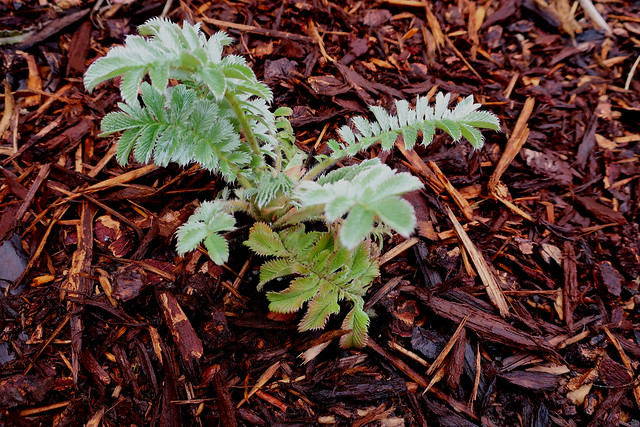

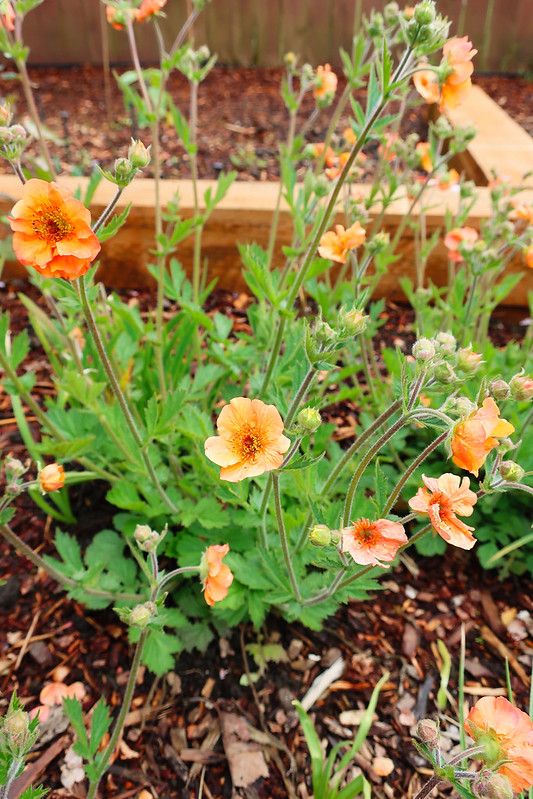



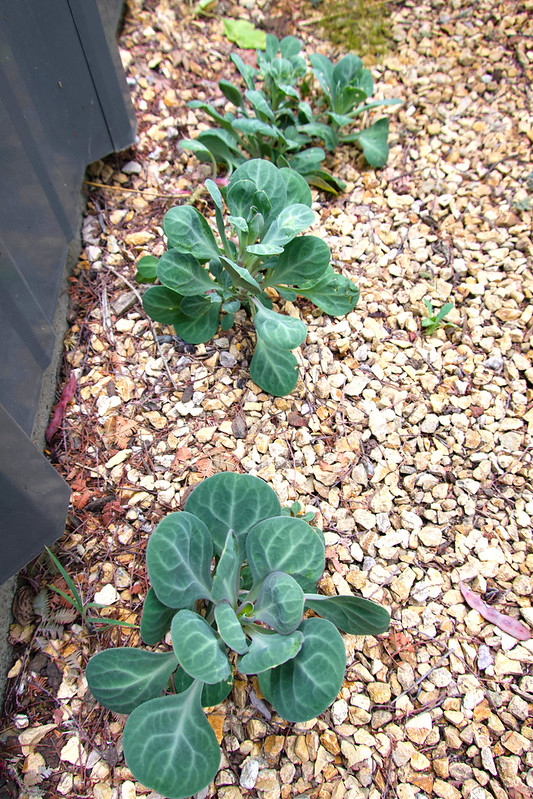



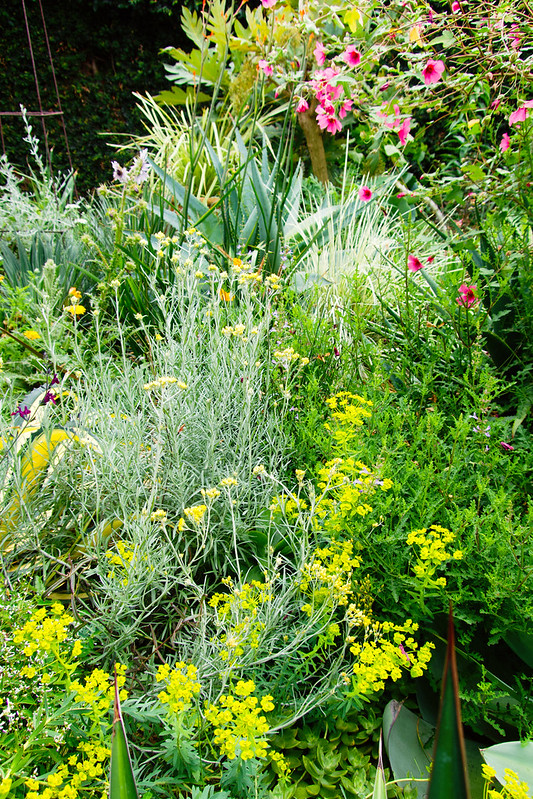



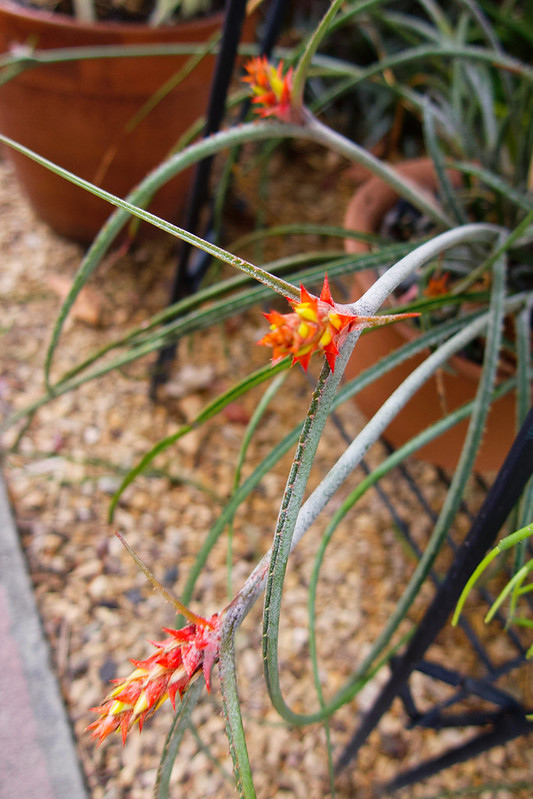

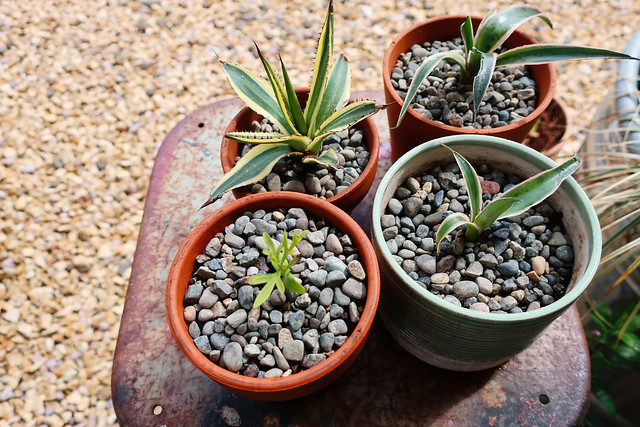
Jumping from wet zone 8b to dry zone 10b, then back again has got to be fun. Your Long Beach garden looks lush to my eyes but then we’ve had days of gusty winds this week and our afternoon temperature hit 90F today. I’ve been shocked at how fast things are withering as I try to limit my water use without just giving up on all the cool season blooms that took their time developing this spring. San Pedro had a wildfire I could see from my kitchen window last evening too, which was unnerving after what happened in Laguna Niguel earlier in the week. It may be a tough summer…
Oh this is a fun collection of photos, I’m going to enjoy watching your style take hold in the new garden and comparing it to your Long Beach garden. As for this spring’s weather, ugh. It’s not usually this bad! There would have normally been a warm week here and there. Plenty of blue sky breaks to get out and appreciate the bright spring growth…
What’s the toothy foliage in the upper left of the ” weeding out seedlings from the dry-laid bricks” photo? Way cool.
Now you can have Tulips every spring without having to store them in the fridge first! And all the rain you can stand. I could sure go for that. Though not being able to go out to play in the dirt anytime would be rather strange.
@Kris, what a shock to hear about the San Pedro fire! I used to play in the canyon near Peck Park, which is where I assume it was centered.
@Loree, the blue skies and warm temps in the wine country made for an amazing day Saturday — I might have to use that escape hatch more often!
@Hoov, upper left would be Centaurea clementei. I started some from seed and brought a small plant north too — I wonder where it will bloom best, if at all?
Must seem a bit like the Twilight Zone bopping back and forth. However, your Long Beach garden looks like it is faring well. A sign the gardener made good plant choices. It’s kind of neat to see it’s progression into a blowsier style. Spring in the PNW is always a bit up and down but it doesn’t last all that long.